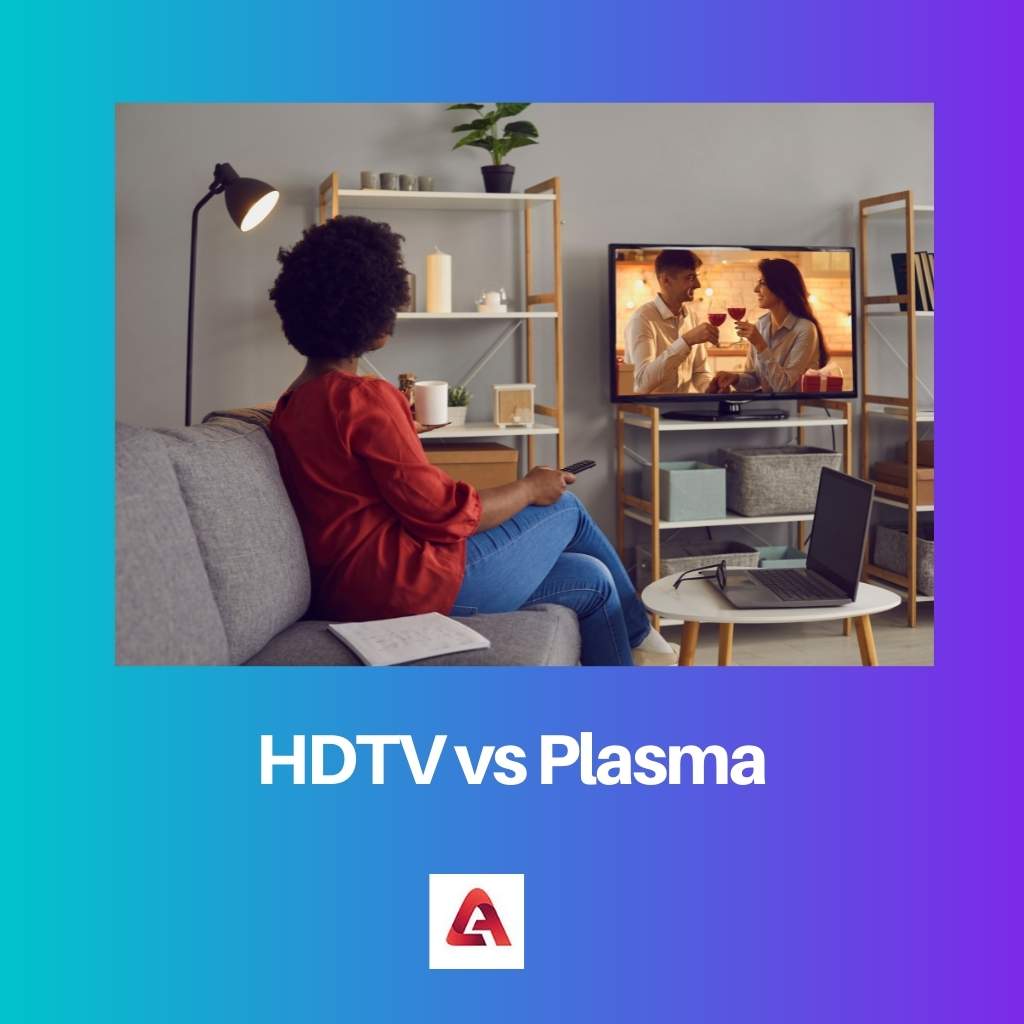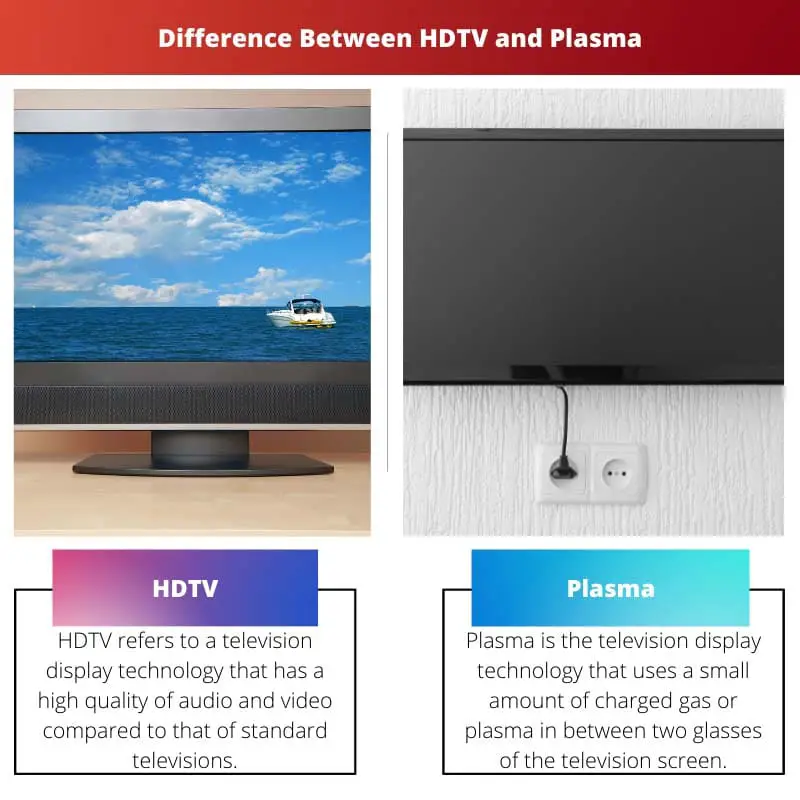In the early days, buying television was easy as there was no variation in the technology. People were just concerned about the brand and the screen size of the television.
But over time, the technology of television has evolved greatly. Each television technology has a specific display method. HDTV and plasma technology are one of these technologies.
Key Takeaways
- HDTV is a high-definition television standard, while plasma refers to a specific type of flat-panel display technology.
- Plasma TVs offer superior color accuracy, contrast ratios, and motion handling compared to many other display types, including some HDTVs.
- Plasma technology is no longer in production, whereas HDTV standards continue to evolve with advancements in display technology.
HDTV vs Plasma
HDTV stands for High Definition Television and is a digital broadcasting standard that provides top-quality picture and audio compared to a normal television. Plasma is a television display technology in which each pixel on the television screen is illuminated by a small amount of charged plasma.

HDTV, or High-Definition Television, is a digital broadcasting standard that provides superior quality of audio and picture compared to that of standard televisions.
One of the most significant features of HDTVs is its wide view screen, which is measured at 16:9. Research shows wide-view TV screens enhance the experience of the viewers.
Plasma refers to a television display technology where each pixel on the television screen is illuminated by a small amount of charged gas or plasma.
Two thin glasses encased the plasma on the TV screen. Generally, plasma screens provide a better wider viewing and dark-room viewing experience compared to LCD.
Comparison Table
| Parameters of Comparison | HDTV | Plasma |
|---|---|---|
| Definition | HDTV or High Definition Television refers to a television display technology that has a high quality of audio and video compared to that of standard televisions. | Plasma is the television display technology that uses a small amount of charged gas or plasma in between two glasses of the television screen. |
| Size | HDTV can be made in smaller sizes compared to plasma TVs. 20 inches or less than 20 inches are very common sizes of HDTVs. | Plasma TVs cannot be made in small sizes. The smallest plasma television is 30 inches. The largest plasma television has a 150 inches screen. |
| Type | HDTV or High Definition Television indicates the resolution of television. It provides higher-quality audio and video. | Plasma television refers to a technology used in television by using charged gas or plasma in between two glasses of the screen. |
| Invention | HDTV was invented in the US in the early 1900s. | Plasma technology was invented in 1964 at the University of Illinois. |
| Correlation | Not all HDTVs are plasma TVs. | All plasma TVs are HDTVs. |
What is HDTV?
HDTV refers to the High Definition of Television, which is a new means of TV broadcasting. HDTV broadcasts video digitally and of a higher resolution of 720 P or 1080 I (P stands for pixel, and I stands for interlaced scanning).
It provides superior quality audio and pictures compared to that of standard televisions. Generally, digital transmission is used in HDTV rather than analog signal transmission.
However, Japan introduced the first analog HDTV program in 1989.
One of the most significant features of HDTVs is its wide view screen, which is measured at 16:9. Research shows wide-view TV screens enhance the experience of the viewers.
The pixel number of HDTV ranges from 2 million to 1 million. It also provides a high-quality audio signal compared to that of standard-definition television.
For watching HDTV, an HDTV-compatible television is needed. HDTV comes in both 4:3 and 16:9 formats (for compatibility and backward).
Some of the High Definition Televisions include HDTV tuners to receive over-the-air broadcasts. The enhanced resolution is one of the advantages of HDTV. The image display technology of HDTV is progressive instead of interlaced.
It means instead of alternating between the partial display of the picture, the whole picture is continuously shown on HDTV.

What is Plasma?
Plasma refers to the television display technology that uses a small amount of charged gas or plasma in between two glasses of the television screen.
Plasma displays offer a wider viewing and better dark-room viewing experience compared to that of LCD TVs.
The plasma technology was invented in 1964 at the University of Illinois by H. Gene Slottow, Donald Bitzer, and a student named Robert Willson.
Plasma TVs cannot be made in small sizes. The smallest plasma television is 30 inches. The largest plasma television has a 150-inch screen.
Plasma TVs are vulnerable to burn-in, which is an issue caused by a static image appearing on the television screen, like a channel number or a logo.
When it remains on the television screen for a long time, there is a chance of burning the image into the television screen.
One of the main advantages of Plasma TVs is their wide viewing angles. The black-level performance sharpens the picture by compensating the ambient light. In higher-end models of plasma, the picture quality is excellent.
The high refresh rate makes the picture smoother and omits the motion blur.
But plasma televisions have some disadvantages too. It consumes more power compared to other LCD TVs. It is also slightly heavy. The TV screen, made of glass, can reflect light, which decreases the viewing experience.

Main Differences Between HDTV and Plasma
- HDTV or high-definition television refers to a television display technology that has a high quality of audio and video compared to that of standard televisions. On the other hand, plasma is the television display technology that uses a small amount of charged gas or plasma in between two glasses of the television screen.
- HDTV can be made in smaller sizes compared to plasma TVs. 20 inches or less than 20 inches are very common sizes of HDTVs. But plasma TVs cannot be made in small sizes. The smallest plasma television is 30 inches. The largest plasma television has a 150-inch screen.
- HDTV or high-definition television indicates the resolution of the television. It provides higher-quality audio and video. On the other hand, Plasma television refers to a technology used in television by using charged gas or plasma between two glasses of the screen.
- HDTV was invented in the US in the early 1900s. Plasma technology was invented in 1964 at the University of Illinois.
- Not all HDTVs are plasma TVs, but All plasma TVs are HDTVs.

- https://ieeexplore.ieee.org/abstract/document/6116383
- https://sid.onlinelibrary.wiley.com/doi/abs/10.1889/1.2036376

The article succeeds in dissecting the contrasting features of HDTV and Plasma. Great read!
Absolutely, Lloyd. It’s an engaging analysis of two television technologies.
I found the explanation of HDTV and Plasma technologies so clear and comprehensive.
I always considered buying a plasma TV, but now I’m reconsidering my options after reading this.
Who knew plasma TVs couldn’t be made in small sizes? This article provides so many intriguing details.
Is it just me, or is the bashing of Plasma TVs in this article a bit too much?
Yes, that’s a surprising fact about plasma TVs.
The burning issue of static images on plasma TVs is a serious downside. It should be made more evident in the article.
I agree with you, Shaw. That’s a very important factor to consider when deciding whether to buy a Plasma TV.
The technological evolution of televisions is such an interesting topic to explore. Great article!
I couldn’t agree more, Jjones. The comparison between HDTV and Plasma was very enlightening.
Very informative article that gives a detailed comparison between HDTV and Plasma. The technology of television has indeed come a long way.
Great piece for those in the market for a new television. The comparison table was particularly helpful.
Fully agree. That table provided a quick and clear overview of the main differences.
I have to disagree. The advantages of Plasma TVs outweigh the disadvantages. Their picture quality is exceptional.
I’m with you on this, Ruth. The article should’ve emphasized the strengths of Plasma TVs more.
Differently, there are many valid arguments in favour of HDTV. I wouldn’t rush on that conclusion of yours, Ruth.